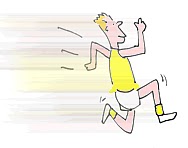Ok when people talk about weight loss it really gets to me. A lot of people say they want to lose weight, I reply ‘cut of your leg this will help you lose weight. Different people call losing weight different things like cutting up or getting more defined they all share the same goal to remove excess body fat. Lets not beat around the bush, you want to lose excess body fat that is no good to anyone that hangs off various body parts and offers you nothing in return.
So how do we lose unwanted body fat?
Very simple, energy in (food) needs to be less as energy out (exercise).
If you’re exercising or running couple times a week and your not losing any weight…. Heres why,
Let take an example
Jo eat roughly 2000 calories (RDA for a women) a day and doesn’t exercise. She has stayed the same weight for a year now so we know 2000 calories is her RDA ( this can change due to your size and muscle mass). One day Jo starts to run 3 x 3 miles a week, each run she burns roughly 300 calories. So the 3 runs burns nearly an extra 1000 calories a week, simply this in turn will lead to fat loss.
After 3 months of this Jo has lost a stone in weight (fat) and is looking good, she continues to train the same as before 3 x 3 miles hoping for more weight loss. But after 1 more month she hasn’t lost any more weight….. Why is this?
One reason for this is because Jo’s body has got used to this exercise thereby reducing its effect significantly, less calories burned. Also she isn’t carrying that extra stone of fat with here making the 3 mile run easier. Here whole body is know more efficient at running and doesn’t need so much fuel to get here though 3 miles.
What to do?
You need to add to your training. You could try a faster pace, run for longer, add hill reps or body weight exercise like squats or lunges. You could also try HIIT training sessions. What every you do you need so add something that will over load the body in turn burning more calories.




